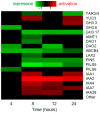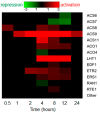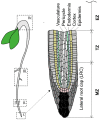Deciphering Auxin-Ethylene Crosstalk at a Systems Level
- PMID: 30558241
- PMCID: PMC6321013
- DOI: 10.3390/ijms19124060
Deciphering Auxin-Ethylene Crosstalk at a Systems Level
Abstract
The auxin and ethylene pathways cooperatively regulate a variety of developmental processes in plants. Growth responses to ethylene are largely dependent on auxin, the key regulator of plant morphogenesis. Auxin, in turn, is capable of inducing ethylene biosynthesis and signaling, making the interaction of these hormones reciprocal. Recent studies discovered a number of molecular events underlying auxin-ethylene crosstalk. In this review, we summarize the results of fine-scale and large-scale experiments on the interactions between the auxin and ethylene pathways in Arabidopsis. We integrate knowledge on molecular crosstalk events, their tissue specificity, and associated phenotypic responses to decipher the crosstalk mechanisms at a systems level. We also discuss the prospects of applying systems biology approaches to study the mechanisms of crosstalk between plant hormones.
Keywords: apical hook; lateral root development; mathematical modeling; phytohormone; root elongation; root hair formation; transcriptional regulation.
Conflict of interest statement
The authors declare no conflict of interest.
Figures






Similar articles
-
Ethylene Inhibits Root Elongation during Alkaline Stress through AUXIN1 and Associated Changes in Auxin Accumulation.Plant Physiol. 2015 Aug;168(4):1777-91. doi: 10.1104/pp.15.00523. Epub 2015 Jun 24. Plant Physiol. 2015. PMID: 26109425 Free PMC article.
-
Abscisic acid regulates root growth under osmotic stress conditions via an interacting hormonal network with cytokinin, ethylene and auxin.New Phytol. 2016 Jul;211(1):225-39. doi: 10.1111/nph.13882. Epub 2016 Feb 18. New Phytol. 2016. PMID: 26889752 Free PMC article.
-
Root Gravitropism Is Regulated by a Crosstalk between para-Aminobenzoic Acid, Ethylene, and Auxin.Plant Physiol. 2018 Nov;178(3):1370-1389. doi: 10.1104/pp.18.00126. Epub 2018 Oct 1. Plant Physiol. 2018. PMID: 30275058 Free PMC article.
-
Crosstalk Complexities between Auxin, Cytokinin, and Ethylene in Arabidopsis Root Development: From Experiments to Systems Modeling, and Back Again.Mol Plant. 2017 Dec 4;10(12):1480-1496. doi: 10.1016/j.molp.2017.11.002. Epub 2017 Nov 21. Mol Plant. 2017. PMID: 29162416 Review.
-
Regulation of seedling growth by ethylene and the ethylene-auxin crosstalk.Planta. 2017 Mar;245(3):467-489. doi: 10.1007/s00425-017-2651-6. Epub 2017 Feb 10. Planta. 2017. PMID: 28188422 Review.
Cited by
-
Halotropism: Phytohormonal Aspects and Potential Applications.Front Plant Sci. 2020 Sep 17;11:571025. doi: 10.3389/fpls.2020.571025. eCollection 2020. Front Plant Sci. 2020. PMID: 33042187 Free PMC article. Review.
-
Regulatory mechanisms of trichome and root hair development in Arabidopsis.Plant Mol Biol. 2024 Dec 30;115(1):14. doi: 10.1007/s11103-024-01534-w. Plant Mol Biol. 2024. PMID: 39739145 Review.
-
The microtubule-associated protein WDL4 modulates auxin distribution to promote apical hook opening in Arabidopsis.Plant Cell. 2021 Jul 19;33(6):1927-1944. doi: 10.1093/plcell/koab080. Plant Cell. 2021. PMID: 33730147 Free PMC article.
-
1-Aminocyclopropane 1-Carboxylic Acid and Its Emerging Role as an Ethylene-Independent Growth Regulator.Front Plant Sci. 2019 Dec 5;10:1602. doi: 10.3389/fpls.2019.01602. eCollection 2019. Front Plant Sci. 2019. PMID: 31921251 Free PMC article. Review.
-
AUXIN RESPONSE FACTOR 1 Acts as a Positive Regulator in the Response of Poplar to Trichoderma asperellum Inoculation in Overexpressing Plants.Plants (Basel). 2020 Feb 19;9(2):272. doi: 10.3390/plants9020272. Plants (Basel). 2020. PMID: 32092896 Free PMC article.
References
-
- Marchant A., Bhalerao R., Casimiro I., Eklöf J., Casero P.J., Bennett M., Sandberg G. AUX1 promotes lateral root formation by facilitating indole-3-acetic acid distribution between sink and source tissues in the Arabidopsis seedling. Plant Cell. 2002;14:589–597. doi: 10.1105/tpc.010354. - DOI - PMC - PubMed
Publication types
MeSH terms
Substances
Grants and funding
LinkOut - more resources
Full Text Sources

